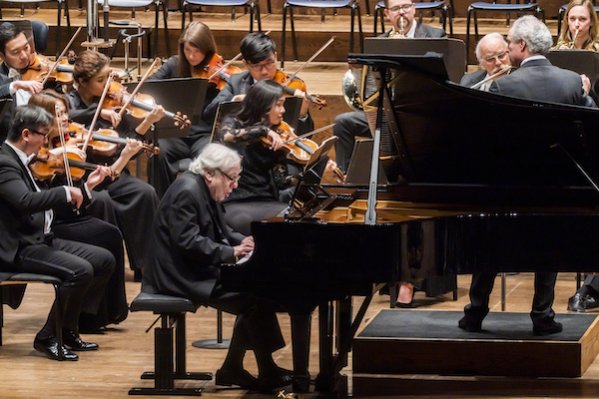A mixed night of retrofitted Mozart from Honeck, Philharmonic

Richard Goode performed Mozart’s Piano Concerto No. 27 with Manfred Honeck conducting the New York Philharmonic Wednesday night at David Geffen Hall. Photo: Chris Lee
Wednesday night’s New York Philharmonic concert was all Mozart. In fact it was more than Mozart, or at least that was the target.
But the aim was a little wide and a little short. Chalk that up to the concert’s conception from guest conductor Manfred Honeck , who, uncharacteristically, didn’t always seem to clearly see what he had on his hands.
The program featured two show-stoppers: Richard Goode playing the Piano Concerto No. 27 in B-flat major, K. 595, to open the evening, and the Requiem after intermission with additional musical context chosen by Honeck.
The concerto performance was a little too relaxed, and everyone seemed to need time to warm up, Both the violins and the soloist were casually sloppy at times in the first movement.
Goode played the first movement cadenza with improved discipline, and the remaining two movements were tighter. But the energy level never rose above a gentle simmer, there was never a feeling of Mozartian velocity, the kind of eager sprinting into the future that is a staple of his aesthetic. This wasn’t bothersome because the performance never gripped the imagination.
The second half was Honeck’s high concept. Centered around the Requiem, it was in the guise of an extended funeral, with the Requiem itself bookended by the Masonic Funeral Music and Ave verum corpus.
The first sound was the tolling of the tubular bells, then came the funeral music. As in the first half, this began without much energy, not sluggish but disinterested. And as with the concerto, this was a surprise, as Honeck is the kind of musician who consistently brings out the force that, like the nucleus of an atom, is built into the structures of harmonic rhythm.
After a few more bell strokes, the Requiem was an enormous step up from the music that had come before. Honeck himself expressed a far greater physical energy, and the commitment from the musicians was proportionally greater as well.
The key to this was the Westminster Symphonic Choir. We live in an age where there seem to be nothing but strong choruses, not just technically skillful but full of a sense of pleasure and purpose in their singing. The Choir’s sound was transparent and warm, and their presence and energy boosted every passage in which they sang to loftier heights.
The soloists, who here seemed more a secondary part of the composition than usual, were fine throughout. Soprano Joélle Harvey stood out for the lovely purity of her tone, and Ben Bliss showed why he is one of the leading Mozartian tenors on the scene today. Mezzo-soprano Megan Mikailovna Samarin in her Philharmonic debut and bass Matthew Rose were both impeccable.
But the foundation of Honeck’s idea was that they would play the “incomplete” Requiem, “as Mozart left it,” according to the program. At David Geffen Hall, that meant everything from the Introit through the first two parts of the Offertory, “Domine Jesu” and “Hostias.” Then, Honeck repeated the “Lacrimosa” in its fragmentary form, cutting it off with a crescendo before beginning Ave verum corpus attacca.
The problem is that Honeck’s determined argument was unsupported by the text. To play the Requiem strictly as Mozart left it means playing the Introitus and probably the Kyrie—Mozart finished the full score of the former and left the complete vocal parts and bass line for the latter. One of Mozart’s students orchestrated the Kyrie, and so once that began Honeck was already playing something other than Mozart.
Outside of the Introitus, the score that Mozart left was like the Kyrie, just vocal parts and bass lines. With those and the key signatures, a small cohort of composers that Mozart’s widow Constanze hired filled out the rest. But just as they had to approximate Mozart’s handwriting, so they had to approximate how Mozart might have used the orchestra and filled out the harmonic structure with dissonances and modulations. This supposed complete Mozart is still mostly not Mozart.
This was a forceful performance, but it was also a forceful argument for something that was inherently false. So despite an intensely beautiful Ave verum corpus—the chorus, hushed, had put down their books and gently swayed with the music—one left this concert/lecture with a feeling of musical dissatisfaction.
This program will be repeated 8 p.m. Friday and Saturday, and 7:30 p.m. Tuesday. nyphil.org







Posted Mar 20, 2019 at 10:36 am by Daniel F.
I heard this concert six days later. I believe that if the reviewer could have suspended his “ology” and simply listened to the “music”, especially the juxtaposition of the Requiem’s non-ending with perhaps the slowest and softest “Ave Verum Corpus” anyone has ever heard, he’d have gotten the point: the arrangement was a Requiem for Mozart. For me at least, it was beyond moving, perhaps the most purely moving concert I have heard at the Philharmonic since Barbirolli conducted the Mahler 9th in the early 60’s. The audience, which filled the still-unfortunate hall, responded with a long series of sustained and appropriately restrained ovations.